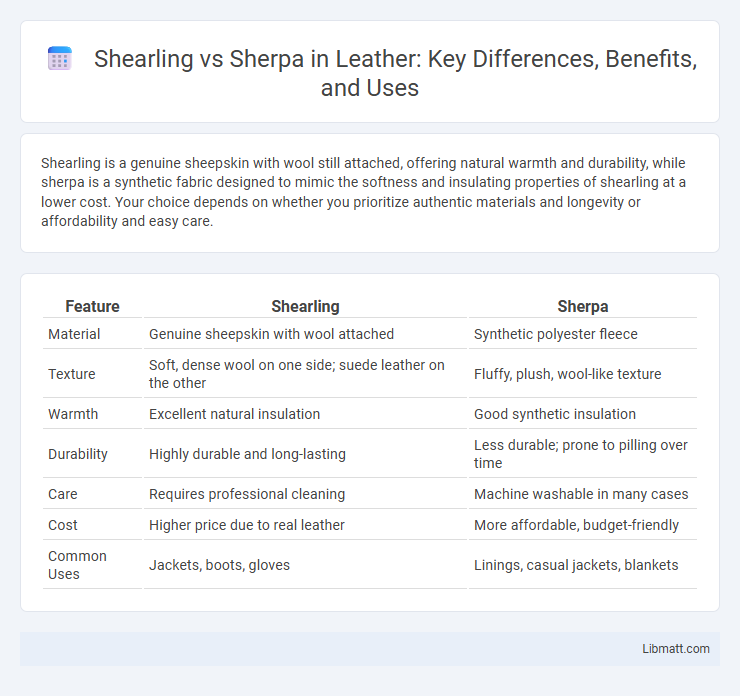Shearling is a genuine sheepskin with wool still attached, offering natural warmth and durability, while sherpa is a synthetic fabric designed to mimic the softness and insulating properties of shearling at a lower cost. Your choice depends on whether you prioritize authentic materials and longevity or affordability and easy care.
Table of Comparison
| Feature | Shearling | Sherpa |
|---|---|---|
| Material | Genuine sheepskin with wool attached | Synthetic polyester fleece |
| Texture | Soft, dense wool on one side; suede leather on the other | Fluffy, plush, wool-like texture |
| Warmth | Excellent natural insulation | Good synthetic insulation |
| Durability | Highly durable and long-lasting | Less durable; prone to pilling over time |
| Care | Requires professional cleaning | Machine washable in many cases |
| Cost | Higher price due to real leather | More affordable, budget-friendly |
| Common Uses | Jackets, boots, gloves | Linings, casual jackets, blankets |
Understanding Shearling: Definition and Origins
Shearling is a natural material made from the skin of a recently shorn sheep, with the wool still attached, offering exceptional warmth and durability. Originating from traditional sheepskin crafts, shearling has been prized for centuries in cold climates due to its insulating properties and breathable texture. Understanding shearling helps you appreciate its unique combination of leather exterior and soft wool interior, distinguishing it from synthetic alternatives like sherpa.
What is Sherpa? Material Overview
Sherpa is a soft, synthetic fabric designed to mimic the look and feel of natural shearling wool, typically made from polyester or acrylic fibers. Known for its plush, fluffy texture, sherpa provides excellent warmth and breathability, making it a popular choice for jackets, linings, and blankets. Your selection between sherpa and shearling depends on factors like animal welfare preferences, durability, and maintenance requirements.
Key Differences Between Shearling and Sherpa
Shearling is genuine sheepskin with the wool still attached, offering natural warmth and durability, while Sherpa is a synthetic fabric designed to mimic the fluffy texture of shearling but lacks the same insulating properties. Shearling's natural fibers provide better breathability and moisture-wicking, making it more comfortable for long-term wear compared to Sherpa's polyester-based material. The high cost and maintenance of shearling contrast with Sherpa's affordability and ease of care, which influences their use in fashion and outdoor apparel.
Natural vs Synthetic: Material Composition
Shearling consists of natural sheepskin with the wool still attached, providing authentic warmth and breathability due to its organic fiber structure. Sherpa is a synthetic fabric made primarily from polyester, designed to mimic the texture and softness of natural wool but lacks the moisture-wicking properties of genuine sheepskin. The material composition difference impacts durability, insulation, and environmental footprint, with shearling offering superior natural thermal regulation and sustainability compared to the man-made fibers of sherpa.
Warmth and Insulation Comparison
Shearling offers superior warmth and natural breathability due to its tanned lambskin paired with the wool fleece, providing excellent insulation in extreme cold. Sherpa, made from synthetic polyester fibers, mimics the insulating properties of shearling but generally offers less heat retention and moisture-wicking capabilities. While shearling excels in authentic thermal regulation, sherpa remains a lightweight, budget-friendly alternative with adequate warmth for mild to moderately cold conditions.
Comfort and Feel: Shearling vs Sherpa
Shearling offers a luxurious, dense wool texture that provides exceptional warmth and softness due to its natural lambskin fleece, making it ideal for cold climates. Sherpa fabric mimics shearling's fluffy appearance but is synthetic, delivering lightweight plush comfort and breathability while being more affordable and easy to maintain. Both materials excel in softness, but shearling's natural fibers give it a richer, more durable feel, whereas sherpa emphasizes cozy, cruelty-free versatility.
Durability and Longevity
Shearling offers superior durability and longevity due to its natural sheepskin composition with a tightly tanned leather backing, making it highly resistant to wear and tear. Sherpa, often made from synthetic fibers, provides softness and warmth but tends to have a shorter lifespan and may pill or flatten over time. Choosing shearling ensures your garment maintains its structure and comfort through prolonged use, making it a more lasting investment.
Style and Fashion Versatility
Shearling offers a luxurious, natural wool texture that elevates classic and high-end outerwear, providing timeless style favored in luxury fashion circles. Sherpa, made from synthetic fleece, delivers a casual and cozy aesthetic popular in streetwear and athleisure trends, making it versatile for everyday layering. Both materials adapt well to modern fashion, with shearling excelling in sophisticated looks while sherpa suits more relaxed, casual outfits.
Price Differences and Affordability
Shearling, made from genuine sheepskin with wool on one side, typically commands a higher price due to its natural materials and durability, often ranging from $200 to $600 or more for jackets and coats. Sherpa, a synthetic fabric designed to mimic shearling's texture, offers a more affordable option, commonly priced between $30 and $150, making it accessible for budget-conscious consumers. The significant price difference stems from shearling's real leather and wool composition versus sherpa's polyester or acrylic fibers, impacting both cost and longevity.
Choosing the Right Option for You
Shearling features authentic sheepskin with a wool interior, offering superior warmth and natural breathability ideal for extreme cold. Sherpa, made from synthetic fleece, provides a lightweight, budget-friendly alternative with easy care and a soft texture suitable for milder climates. Selecting between shearling and sherpa depends on your preferences for insulation, durability, cost, and maintenance requirements.
Shearling vs sherpa Infographic

 libmatt.com
libmatt.com